Assignment about Nursing Professionals
VerifiedAdded on 2022/09/22
|9
|4197
|55
Assignment
AI Summary
Contribute Materials
Your contribution can guide someone’s learning journey. Share your
documents today.
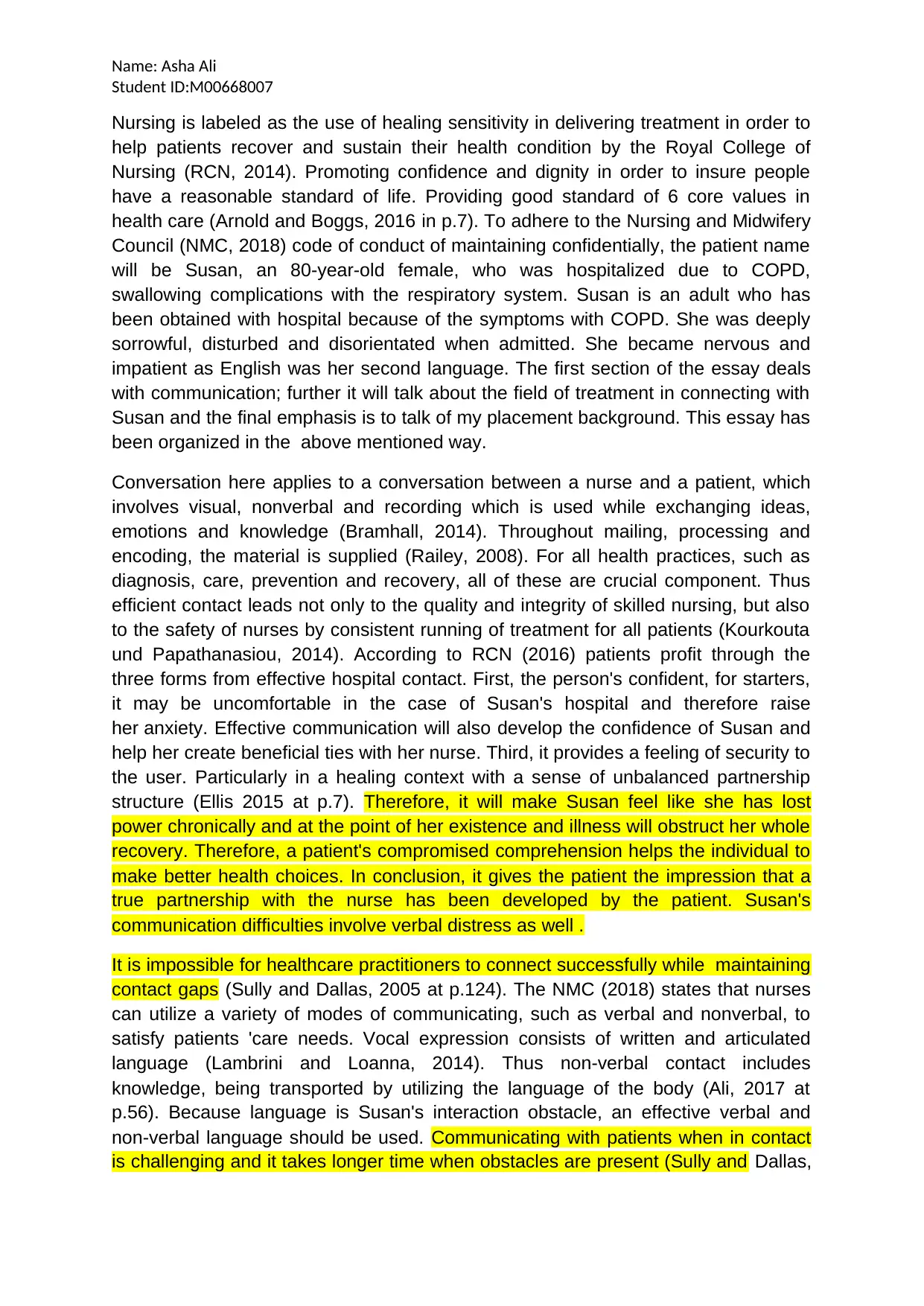
Name: Asha Ali
Student ID:M00668007
Nursing is labeled as the use of healing sensitivity in delivering treatment in order to
help patients recover and sustain their health condition by the Royal College of
Nursing (RCN, 2014). Promoting confidence and dignity in order to insure people
have a reasonable standard of life. Providing good standard of 6 core values in
health care (Arnold and Boggs, 2016 in p.7). To adhere to the Nursing and Midwifery
Council (NMC, 2018) code of conduct of maintaining confidentially, the patient name
will be Susan, an 80-year-old female, who was hospitalized due to COPD,
swallowing complications with the respiratory system. Susan is an adult who has
been obtained with hospital because of the symptoms with COPD. She was deeply
sorrowful, disturbed and disorientated when admitted. She became nervous and
impatient as English was her second language. The first section of the essay deals
with communication; further it will talk about the field of treatment in connecting with
Susan and the final emphasis is to talk of my placement background. This essay has
been organized in the above mentioned way.
Conversation here applies to a conversation between a nurse and a patient, which
involves visual, nonverbal and recording which is used while exchanging ideas,
emotions and knowledge (Bramhall, 2014). Throughout mailing, processing and
encoding, the material is supplied (Railey, 2008). For all health practices, such as
diagnosis, care, prevention and recovery, all of these are crucial component. Thus
efficient contact leads not only to the quality and integrity of skilled nursing, but also
to the safety of nurses by consistent running of treatment for all patients (Kourkouta
und Papathanasiou, 2014). According to RCN (2016) patients profit through the
three forms from effective hospital contact. First, the person's confident, for starters,
it may be uncomfortable in the case of Susan's hospital and therefore raise
her anxiety. Effective communication will also develop the confidence of Susan and
help her create beneficial ties with her nurse. Third, it provides a feeling of security to
the user. Particularly in a healing context with a sense of unbalanced partnership
structure (Ellis 2015 at p.7). Therefore, it will make Susan feel like she has lost
power chronically and at the point of her existence and illness will obstruct her whole
recovery. Therefore, a patient's compromised comprehension helps the individual to
make better health choices. In conclusion, it gives the patient the impression that a
true partnership with the nurse has been developed by the patient. Susan's
communication difficulties involve verbal distress as well .
It is impossible for healthcare practitioners to connect successfully while maintaining
contact gaps (Sully and Dallas, 2005 at p.124). The NMC (2018) states that nurses
can utilize a variety of modes of communicating, such as verbal and nonverbal, to
satisfy patients 'care needs. Vocal expression consists of written and articulated
language (Lambrini and Loanna, 2014). Thus non-verbal contact includes
knowledge, being transported by utilizing the language of the body (Ali, 2017 at
p.56). Because language is Susan's interaction obstacle, an effective verbal and
non-verbal language should be used. Communicating with patients when in contact
is challenging and it takes longer time when obstacles are present (Sully and Dallas,
Student ID:M00668007
Nursing is labeled as the use of healing sensitivity in delivering treatment in order to
help patients recover and sustain their health condition by the Royal College of
Nursing (RCN, 2014). Promoting confidence and dignity in order to insure people
have a reasonable standard of life. Providing good standard of 6 core values in
health care (Arnold and Boggs, 2016 in p.7). To adhere to the Nursing and Midwifery
Council (NMC, 2018) code of conduct of maintaining confidentially, the patient name
will be Susan, an 80-year-old female, who was hospitalized due to COPD,
swallowing complications with the respiratory system. Susan is an adult who has
been obtained with hospital because of the symptoms with COPD. She was deeply
sorrowful, disturbed and disorientated when admitted. She became nervous and
impatient as English was her second language. The first section of the essay deals
with communication; further it will talk about the field of treatment in connecting with
Susan and the final emphasis is to talk of my placement background. This essay has
been organized in the above mentioned way.
Conversation here applies to a conversation between a nurse and a patient, which
involves visual, nonverbal and recording which is used while exchanging ideas,
emotions and knowledge (Bramhall, 2014). Throughout mailing, processing and
encoding, the material is supplied (Railey, 2008). For all health practices, such as
diagnosis, care, prevention and recovery, all of these are crucial component. Thus
efficient contact leads not only to the quality and integrity of skilled nursing, but also
to the safety of nurses by consistent running of treatment for all patients (Kourkouta
und Papathanasiou, 2014). According to RCN (2016) patients profit through the
three forms from effective hospital contact. First, the person's confident, for starters,
it may be uncomfortable in the case of Susan's hospital and therefore raise
her anxiety. Effective communication will also develop the confidence of Susan and
help her create beneficial ties with her nurse. Third, it provides a feeling of security to
the user. Particularly in a healing context with a sense of unbalanced partnership
structure (Ellis 2015 at p.7). Therefore, it will make Susan feel like she has lost
power chronically and at the point of her existence and illness will obstruct her whole
recovery. Therefore, a patient's compromised comprehension helps the individual to
make better health choices. In conclusion, it gives the patient the impression that a
true partnership with the nurse has been developed by the patient. Susan's
communication difficulties involve verbal distress as well .
It is impossible for healthcare practitioners to connect successfully while maintaining
contact gaps (Sully and Dallas, 2005 at p.124). The NMC (2018) states that nurses
can utilize a variety of modes of communicating, such as verbal and nonverbal, to
satisfy patients 'care needs. Vocal expression consists of written and articulated
language (Lambrini and Loanna, 2014). Thus non-verbal contact includes
knowledge, being transported by utilizing the language of the body (Ali, 2017 at
p.56). Because language is Susan's interaction obstacle, an effective verbal and
non-verbal language should be used. Communicating with patients when in contact
is challenging and it takes longer time when obstacles are present (Sully and Dallas,
Secure Best Marks with AI Grader
Need help grading? Try our AI Grader for instant feedback on your assignments.
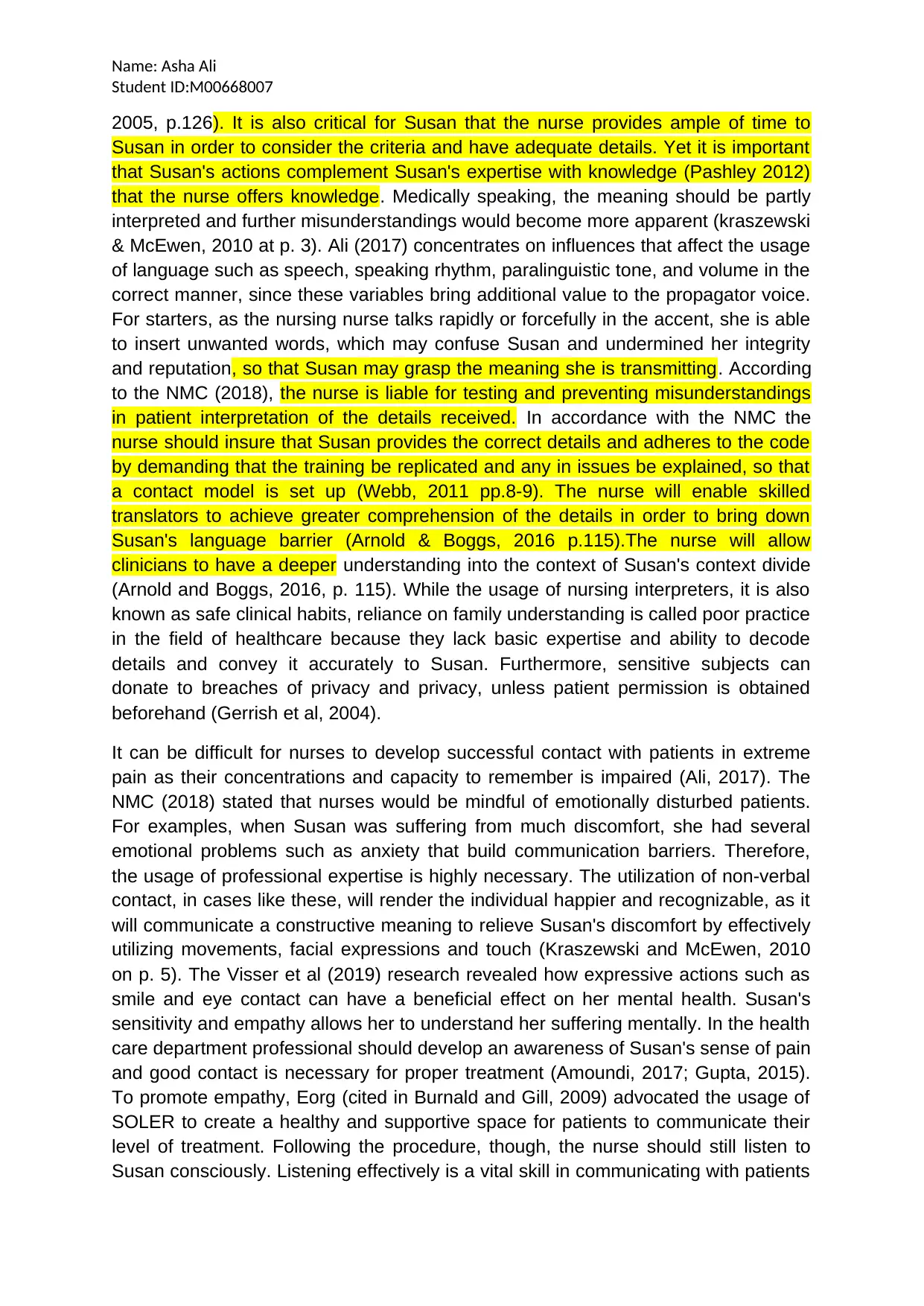
Name: Asha Ali
Student ID:M00668007
2005, p.126). It is also critical for Susan that the nurse provides ample of time to
Susan in order to consider the criteria and have adequate details. Yet it is important
that Susan's actions complement Susan's expertise with knowledge (Pashley 2012)
that the nurse offers knowledge. Medically speaking, the meaning should be partly
interpreted and further misunderstandings would become more apparent (kraszewski
& McEwen, 2010 at p. 3). Ali (2017) concentrates on influences that affect the usage
of language such as speech, speaking rhythm, paralinguistic tone, and volume in the
correct manner, since these variables bring additional value to the propagator voice.
For starters, as the nursing nurse talks rapidly or forcefully in the accent, she is able
to insert unwanted words, which may confuse Susan and undermined her integrity
and reputation, so that Susan may grasp the meaning she is transmitting. According
to the NMC (2018), the nurse is liable for testing and preventing misunderstandings
in patient interpretation of the details received. In accordance with the NMC the
nurse should insure that Susan provides the correct details and adheres to the code
by demanding that the training be replicated and any in issues be explained, so that
a contact model is set up (Webb, 2011 pp.8-9). The nurse will enable skilled
translators to achieve greater comprehension of the details in order to bring down
Susan's language barrier (Arnold & Boggs, 2016 p.115).The nurse will allow
clinicians to have a deeper understanding into the context of Susan's context divide
(Arnold and Boggs, 2016, p. 115). While the usage of nursing interpreters, it is also
known as safe clinical habits, reliance on family understanding is called poor practice
in the field of healthcare because they lack basic expertise and ability to decode
details and convey it accurately to Susan. Furthermore, sensitive subjects can
donate to breaches of privacy and privacy, unless patient permission is obtained
beforehand (Gerrish et al, 2004).
It can be difficult for nurses to develop successful contact with patients in extreme
pain as their concentrations and capacity to remember is impaired (Ali, 2017). The
NMC (2018) stated that nurses would be mindful of emotionally disturbed patients.
For examples, when Susan was suffering from much discomfort, she had several
emotional problems such as anxiety that build communication barriers. Therefore,
the usage of professional expertise is highly necessary. The utilization of non-verbal
contact, in cases like these, will render the individual happier and recognizable, as it
will communicate a constructive meaning to relieve Susan's discomfort by effectively
utilizing movements, facial expressions and touch (Kraszewski and McEwen, 2010
on p. 5). The Visser et al (2019) research revealed how expressive actions such as
smile and eye contact can have a beneficial effect on her mental health. Susan's
sensitivity and empathy allows her to understand her suffering mentally. In the health
care department professional should develop an awareness of Susan's sense of pain
and good contact is necessary for proper treatment (Amoundi, 2017; Gupta, 2015).
To promote empathy, Eorg (cited in Burnald and Gill, 2009) advocated the usage of
SOLER to create a healthy and supportive space for patients to communicate their
level of treatment. Following the procedure, though, the nurse should still listen to
Susan consciously. Listening effectively is a vital skill in communicating with patients
Student ID:M00668007
2005, p.126). It is also critical for Susan that the nurse provides ample of time to
Susan in order to consider the criteria and have adequate details. Yet it is important
that Susan's actions complement Susan's expertise with knowledge (Pashley 2012)
that the nurse offers knowledge. Medically speaking, the meaning should be partly
interpreted and further misunderstandings would become more apparent (kraszewski
& McEwen, 2010 at p. 3). Ali (2017) concentrates on influences that affect the usage
of language such as speech, speaking rhythm, paralinguistic tone, and volume in the
correct manner, since these variables bring additional value to the propagator voice.
For starters, as the nursing nurse talks rapidly or forcefully in the accent, she is able
to insert unwanted words, which may confuse Susan and undermined her integrity
and reputation, so that Susan may grasp the meaning she is transmitting. According
to the NMC (2018), the nurse is liable for testing and preventing misunderstandings
in patient interpretation of the details received. In accordance with the NMC the
nurse should insure that Susan provides the correct details and adheres to the code
by demanding that the training be replicated and any in issues be explained, so that
a contact model is set up (Webb, 2011 pp.8-9). The nurse will enable skilled
translators to achieve greater comprehension of the details in order to bring down
Susan's language barrier (Arnold & Boggs, 2016 p.115).The nurse will allow
clinicians to have a deeper understanding into the context of Susan's context divide
(Arnold and Boggs, 2016, p. 115). While the usage of nursing interpreters, it is also
known as safe clinical habits, reliance on family understanding is called poor practice
in the field of healthcare because they lack basic expertise and ability to decode
details and convey it accurately to Susan. Furthermore, sensitive subjects can
donate to breaches of privacy and privacy, unless patient permission is obtained
beforehand (Gerrish et al, 2004).
It can be difficult for nurses to develop successful contact with patients in extreme
pain as their concentrations and capacity to remember is impaired (Ali, 2017). The
NMC (2018) stated that nurses would be mindful of emotionally disturbed patients.
For examples, when Susan was suffering from much discomfort, she had several
emotional problems such as anxiety that build communication barriers. Therefore,
the usage of professional expertise is highly necessary. The utilization of non-verbal
contact, in cases like these, will render the individual happier and recognizable, as it
will communicate a constructive meaning to relieve Susan's discomfort by effectively
utilizing movements, facial expressions and touch (Kraszewski and McEwen, 2010
on p. 5). The Visser et al (2019) research revealed how expressive actions such as
smile and eye contact can have a beneficial effect on her mental health. Susan's
sensitivity and empathy allows her to understand her suffering mentally. In the health
care department professional should develop an awareness of Susan's sense of pain
and good contact is necessary for proper treatment (Amoundi, 2017; Gupta, 2015).
To promote empathy, Eorg (cited in Burnald and Gill, 2009) advocated the usage of
SOLER to create a healthy and supportive space for patients to communicate their
level of treatment. Following the procedure, though, the nurse should still listen to
Susan consciously. Listening effectively is a vital skill in communicating with patients
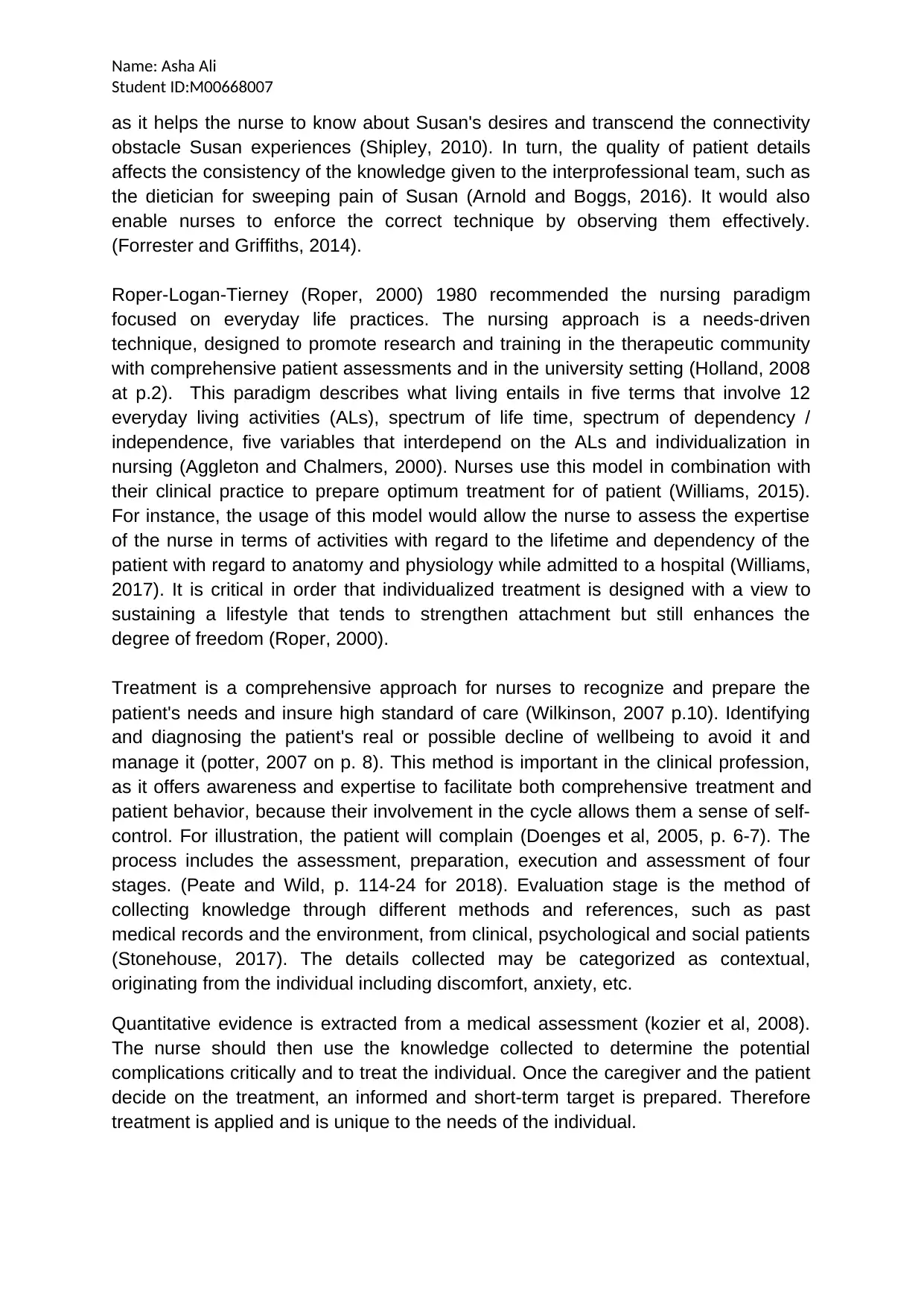
Name: Asha Ali
Student ID:M00668007
as it helps the nurse to know about Susan's desires and transcend the connectivity
obstacle Susan experiences (Shipley, 2010). In turn, the quality of patient details
affects the consistency of the knowledge given to the interprofessional team, such as
the dietician for sweeping pain of Susan (Arnold and Boggs, 2016). It would also
enable nurses to enforce the correct technique by observing them effectively.
(Forrester and Griffiths, 2014).
Roper-Logan-Tierney (Roper, 2000) 1980 recommended the nursing paradigm
focused on everyday life practices. The nursing approach is a needs-driven
technique, designed to promote research and training in the therapeutic community
with comprehensive patient assessments and in the university setting (Holland, 2008
at p.2). This paradigm describes what living entails in five terms that involve 12
everyday living activities (ALs), spectrum of life time, spectrum of dependency /
independence, five variables that interdepend on the ALs and individualization in
nursing (Aggleton and Chalmers, 2000). Nurses use this model in combination with
their clinical practice to prepare optimum treatment for of patient (Williams, 2015).
For instance, the usage of this model would allow the nurse to assess the expertise
of the nurse in terms of activities with regard to the lifetime and dependency of the
patient with regard to anatomy and physiology while admitted to a hospital (Williams,
2017). It is critical in order that individualized treatment is designed with a view to
sustaining a lifestyle that tends to strengthen attachment but still enhances the
degree of freedom (Roper, 2000).
Treatment is a comprehensive approach for nurses to recognize and prepare the
patient's needs and insure high standard of care (Wilkinson, 2007 p.10). Identifying
and diagnosing the patient's real or possible decline of wellbeing to avoid it and
manage it (potter, 2007 on p. 8). This method is important in the clinical profession,
as it offers awareness and expertise to facilitate both comprehensive treatment and
patient behavior, because their involvement in the cycle allows them a sense of self-
control. For illustration, the patient will complain (Doenges et al, 2005, p. 6-7). The
process includes the assessment, preparation, execution and assessment of four
stages. (Peate and Wild, p. 114-24 for 2018). Evaluation stage is the method of
collecting knowledge through different methods and references, such as past
medical records and the environment, from clinical, psychological and social patients
(Stonehouse, 2017). The details collected may be categorized as contextual,
originating from the individual including discomfort, anxiety, etc.
Quantitative evidence is extracted from a medical assessment (kozier et al, 2008).
The nurse should then use the knowledge collected to determine the potential
complications critically and to treat the individual. Once the caregiver and the patient
decide on the treatment, an informed and short-term target is prepared. Therefore
treatment is applied and is unique to the needs of the individual.
Student ID:M00668007
as it helps the nurse to know about Susan's desires and transcend the connectivity
obstacle Susan experiences (Shipley, 2010). In turn, the quality of patient details
affects the consistency of the knowledge given to the interprofessional team, such as
the dietician for sweeping pain of Susan (Arnold and Boggs, 2016). It would also
enable nurses to enforce the correct technique by observing them effectively.
(Forrester and Griffiths, 2014).
Roper-Logan-Tierney (Roper, 2000) 1980 recommended the nursing paradigm
focused on everyday life practices. The nursing approach is a needs-driven
technique, designed to promote research and training in the therapeutic community
with comprehensive patient assessments and in the university setting (Holland, 2008
at p.2). This paradigm describes what living entails in five terms that involve 12
everyday living activities (ALs), spectrum of life time, spectrum of dependency /
independence, five variables that interdepend on the ALs and individualization in
nursing (Aggleton and Chalmers, 2000). Nurses use this model in combination with
their clinical practice to prepare optimum treatment for of patient (Williams, 2015).
For instance, the usage of this model would allow the nurse to assess the expertise
of the nurse in terms of activities with regard to the lifetime and dependency of the
patient with regard to anatomy and physiology while admitted to a hospital (Williams,
2017). It is critical in order that individualized treatment is designed with a view to
sustaining a lifestyle that tends to strengthen attachment but still enhances the
degree of freedom (Roper, 2000).
Treatment is a comprehensive approach for nurses to recognize and prepare the
patient's needs and insure high standard of care (Wilkinson, 2007 p.10). Identifying
and diagnosing the patient's real or possible decline of wellbeing to avoid it and
manage it (potter, 2007 on p. 8). This method is important in the clinical profession,
as it offers awareness and expertise to facilitate both comprehensive treatment and
patient behavior, because their involvement in the cycle allows them a sense of self-
control. For illustration, the patient will complain (Doenges et al, 2005, p. 6-7). The
process includes the assessment, preparation, execution and assessment of four
stages. (Peate and Wild, p. 114-24 for 2018). Evaluation stage is the method of
collecting knowledge through different methods and references, such as past
medical records and the environment, from clinical, psychological and social patients
(Stonehouse, 2017). The details collected may be categorized as contextual,
originating from the individual including discomfort, anxiety, etc.
Quantitative evidence is extracted from a medical assessment (kozier et al, 2008).
The nurse should then use the knowledge collected to determine the potential
complications critically and to treat the individual. Once the caregiver and the patient
decide on the treatment, an informed and short-term target is prepared. Therefore
treatment is applied and is unique to the needs of the individual.
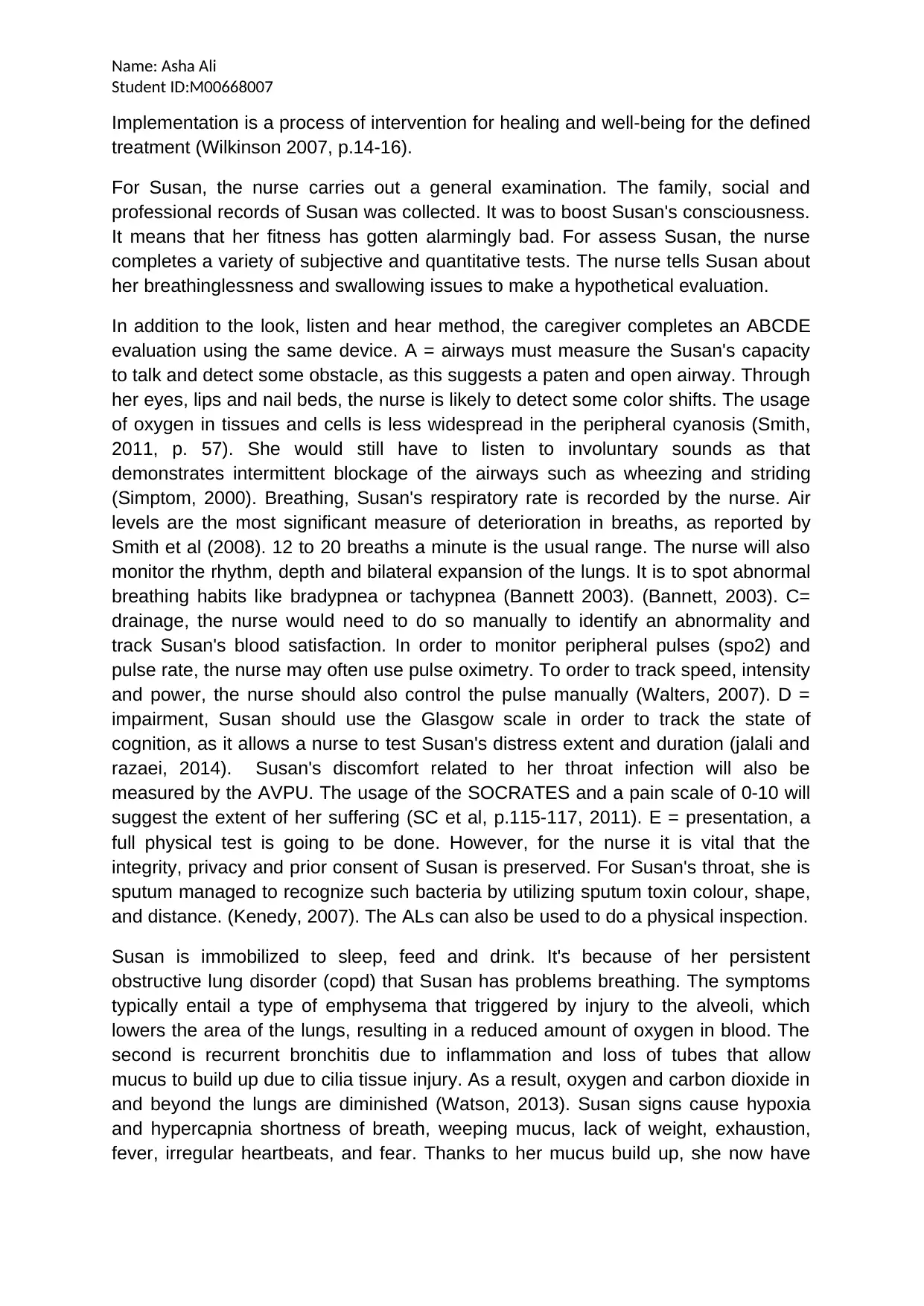
Name: Asha Ali
Student ID:M00668007
Implementation is a process of intervention for healing and well-being for the defined
treatment (Wilkinson 2007, p.14-16).
For Susan, the nurse carries out a general examination. The family, social and
professional records of Susan was collected. It was to boost Susan's consciousness.
It means that her fitness has gotten alarmingly bad. For assess Susan, the nurse
completes a variety of subjective and quantitative tests. The nurse tells Susan about
her breathinglessness and swallowing issues to make a hypothetical evaluation.
In addition to the look, listen and hear method, the caregiver completes an ABCDE
evaluation using the same device. A = airways must measure the Susan's capacity
to talk and detect some obstacle, as this suggests a paten and open airway. Through
her eyes, lips and nail beds, the nurse is likely to detect some color shifts. The usage
of oxygen in tissues and cells is less widespread in the peripheral cyanosis (Smith,
2011, p. 57). She would still have to listen to involuntary sounds as that
demonstrates intermittent blockage of the airways such as wheezing and striding
(Simptom, 2000). Breathing, Susan's respiratory rate is recorded by the nurse. Air
levels are the most significant measure of deterioration in breaths, as reported by
Smith et al (2008). 12 to 20 breaths a minute is the usual range. The nurse will also
monitor the rhythm, depth and bilateral expansion of the lungs. It is to spot abnormal
breathing habits like bradypnea or tachypnea (Bannett 2003). (Bannett, 2003). C=
drainage, the nurse would need to do so manually to identify an abnormality and
track Susan's blood satisfaction. In order to monitor peripheral pulses (spo2) and
pulse rate, the nurse may often use pulse oximetry. To order to track speed, intensity
and power, the nurse should also control the pulse manually (Walters, 2007). D =
impairment, Susan should use the Glasgow scale in order to track the state of
cognition, as it allows a nurse to test Susan's distress extent and duration (jalali and
razaei, 2014). Susan's discomfort related to her throat infection will also be
measured by the AVPU. The usage of the SOCRATES and a pain scale of 0-10 will
suggest the extent of her suffering (SC et al, p.115-117, 2011). E = presentation, a
full physical test is going to be done. However, for the nurse it is vital that the
integrity, privacy and prior consent of Susan is preserved. For Susan's throat, she is
sputum managed to recognize such bacteria by utilizing sputum toxin colour, shape,
and distance. (Kenedy, 2007). The ALs can also be used to do a physical inspection.
Susan is immobilized to sleep, feed and drink. It's because of her persistent
obstructive lung disorder (copd) that Susan has problems breathing. The symptoms
typically entail a type of emphysema that triggered by injury to the alveoli, which
lowers the area of the lungs, resulting in a reduced amount of oxygen in blood. The
second is recurrent bronchitis due to inflammation and loss of tubes that allow
mucus to build up due to cilia tissue injury. As a result, oxygen and carbon dioxide in
and beyond the lungs are diminished (Watson, 2013). Susan signs cause hypoxia
and hypercapnia shortness of breath, weeping mucus, lack of weight, exhaustion,
fever, irregular heartbeats, and fear. Thanks to her mucus build up, she now have
Student ID:M00668007
Implementation is a process of intervention for healing and well-being for the defined
treatment (Wilkinson 2007, p.14-16).
For Susan, the nurse carries out a general examination. The family, social and
professional records of Susan was collected. It was to boost Susan's consciousness.
It means that her fitness has gotten alarmingly bad. For assess Susan, the nurse
completes a variety of subjective and quantitative tests. The nurse tells Susan about
her breathinglessness and swallowing issues to make a hypothetical evaluation.
In addition to the look, listen and hear method, the caregiver completes an ABCDE
evaluation using the same device. A = airways must measure the Susan's capacity
to talk and detect some obstacle, as this suggests a paten and open airway. Through
her eyes, lips and nail beds, the nurse is likely to detect some color shifts. The usage
of oxygen in tissues and cells is less widespread in the peripheral cyanosis (Smith,
2011, p. 57). She would still have to listen to involuntary sounds as that
demonstrates intermittent blockage of the airways such as wheezing and striding
(Simptom, 2000). Breathing, Susan's respiratory rate is recorded by the nurse. Air
levels are the most significant measure of deterioration in breaths, as reported by
Smith et al (2008). 12 to 20 breaths a minute is the usual range. The nurse will also
monitor the rhythm, depth and bilateral expansion of the lungs. It is to spot abnormal
breathing habits like bradypnea or tachypnea (Bannett 2003). (Bannett, 2003). C=
drainage, the nurse would need to do so manually to identify an abnormality and
track Susan's blood satisfaction. In order to monitor peripheral pulses (spo2) and
pulse rate, the nurse may often use pulse oximetry. To order to track speed, intensity
and power, the nurse should also control the pulse manually (Walters, 2007). D =
impairment, Susan should use the Glasgow scale in order to track the state of
cognition, as it allows a nurse to test Susan's distress extent and duration (jalali and
razaei, 2014). Susan's discomfort related to her throat infection will also be
measured by the AVPU. The usage of the SOCRATES and a pain scale of 0-10 will
suggest the extent of her suffering (SC et al, p.115-117, 2011). E = presentation, a
full physical test is going to be done. However, for the nurse it is vital that the
integrity, privacy and prior consent of Susan is preserved. For Susan's throat, she is
sputum managed to recognize such bacteria by utilizing sputum toxin colour, shape,
and distance. (Kenedy, 2007). The ALs can also be used to do a physical inspection.
Susan is immobilized to sleep, feed and drink. It's because of her persistent
obstructive lung disorder (copd) that Susan has problems breathing. The symptoms
typically entail a type of emphysema that triggered by injury to the alveoli, which
lowers the area of the lungs, resulting in a reduced amount of oxygen in blood. The
second is recurrent bronchitis due to inflammation and loss of tubes that allow
mucus to build up due to cilia tissue injury. As a result, oxygen and carbon dioxide in
and beyond the lungs are diminished (Watson, 2013). Susan signs cause hypoxia
and hypercapnia shortness of breath, weeping mucus, lack of weight, exhaustion,
fever, irregular heartbeats, and fear. Thanks to her mucus build up, she now have
Secure Best Marks with AI Grader
Need help grading? Try our AI Grader for instant feedback on your assignments.
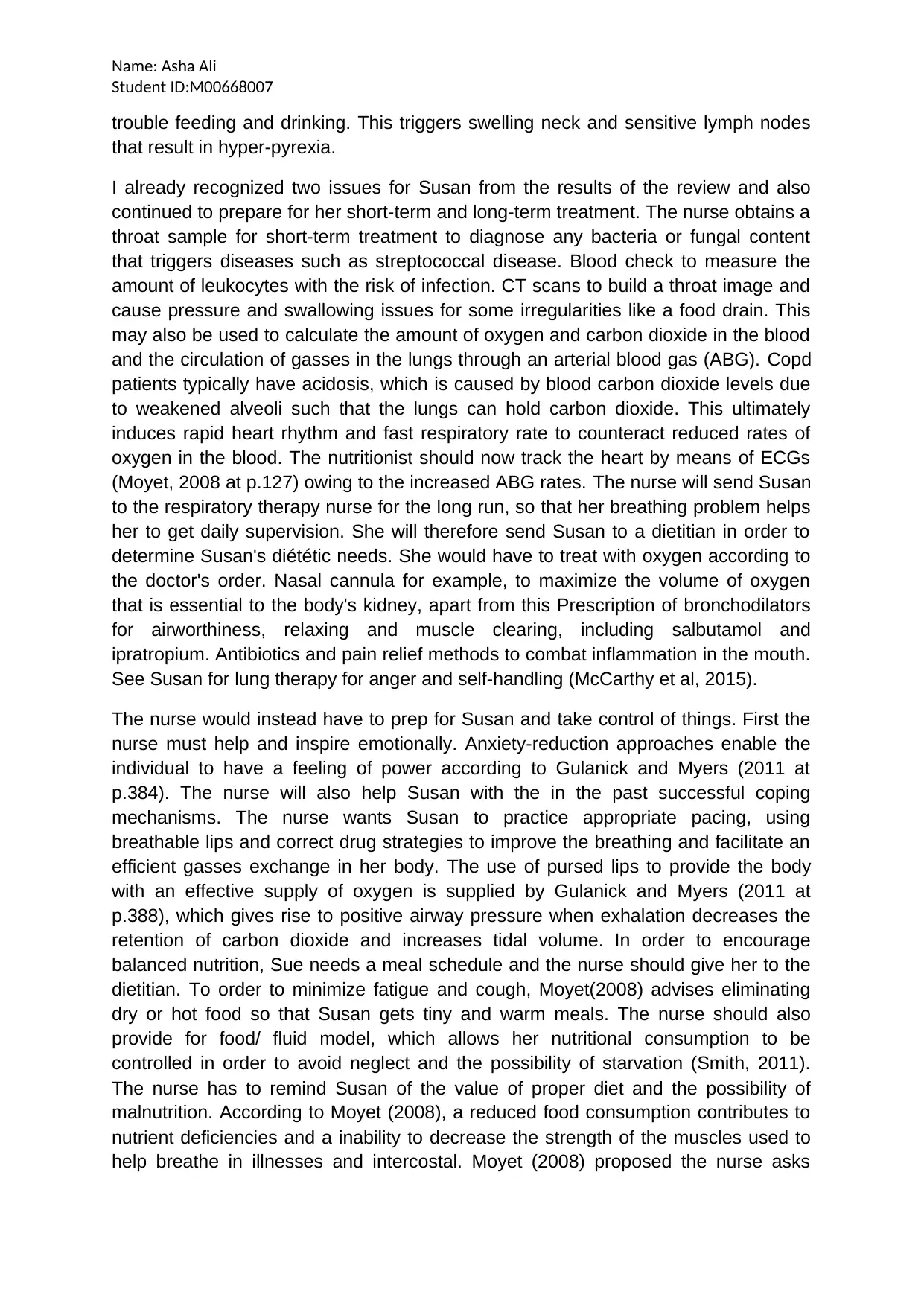
Name: Asha Ali
Student ID:M00668007
trouble feeding and drinking. This triggers swelling neck and sensitive lymph nodes
that result in hyper-pyrexia.
I already recognized two issues for Susan from the results of the review and also
continued to prepare for her short-term and long-term treatment. The nurse obtains a
throat sample for short-term treatment to diagnose any bacteria or fungal content
that triggers diseases such as streptococcal disease. Blood check to measure the
amount of leukocytes with the risk of infection. CT scans to build a throat image and
cause pressure and swallowing issues for some irregularities like a food drain. This
may also be used to calculate the amount of oxygen and carbon dioxide in the blood
and the circulation of gasses in the lungs through an arterial blood gas (ABG). Copd
patients typically have acidosis, which is caused by blood carbon dioxide levels due
to weakened alveoli such that the lungs can hold carbon dioxide. This ultimately
induces rapid heart rhythm and fast respiratory rate to counteract reduced rates of
oxygen in the blood. The nutritionist should now track the heart by means of ECGs
(Moyet, 2008 at p.127) owing to the increased ABG rates. The nurse will send Susan
to the respiratory therapy nurse for the long run, so that her breathing problem helps
her to get daily supervision. She will therefore send Susan to a dietitian in order to
determine Susan's diététic needs. She would have to treat with oxygen according to
the doctor's order. Nasal cannula for example, to maximize the volume of oxygen
that is essential to the body's kidney, apart from this Prescription of bronchodilators
for airworthiness, relaxing and muscle clearing, including salbutamol and
ipratropium. Antibiotics and pain relief methods to combat inflammation in the mouth.
See Susan for lung therapy for anger and self-handling (McCarthy et al, 2015).
The nurse would instead have to prep for Susan and take control of things. First the
nurse must help and inspire emotionally. Anxiety-reduction approaches enable the
individual to have a feeling of power according to Gulanick and Myers (2011 at
p.384). The nurse will also help Susan with the in the past successful coping
mechanisms. The nurse wants Susan to practice appropriate pacing, using
breathable lips and correct drug strategies to improve the breathing and facilitate an
efficient gasses exchange in her body. The use of pursed lips to provide the body
with an effective supply of oxygen is supplied by Gulanick and Myers (2011 at
p.388), which gives rise to positive airway pressure when exhalation decreases the
retention of carbon dioxide and increases tidal volume. In order to encourage
balanced nutrition, Sue needs a meal schedule and the nurse should give her to the
dietitian. To order to minimize fatigue and cough, Moyet(2008) advises eliminating
dry or hot food so that Susan gets tiny and warm meals. The nurse should also
provide for food/ fluid model, which allows her nutritional consumption to be
controlled in order to avoid neglect and the possibility of starvation (Smith, 2011).
The nurse has to remind Susan of the value of proper diet and the possibility of
malnutrition. According to Moyet (2008), a reduced food consumption contributes to
nutrient deficiencies and a inability to decrease the strength of the muscles used to
help breathe in illnesses and intercostal. Moyet (2008) proposed the nurse asks
Student ID:M00668007
trouble feeding and drinking. This triggers swelling neck and sensitive lymph nodes
that result in hyper-pyrexia.
I already recognized two issues for Susan from the results of the review and also
continued to prepare for her short-term and long-term treatment. The nurse obtains a
throat sample for short-term treatment to diagnose any bacteria or fungal content
that triggers diseases such as streptococcal disease. Blood check to measure the
amount of leukocytes with the risk of infection. CT scans to build a throat image and
cause pressure and swallowing issues for some irregularities like a food drain. This
may also be used to calculate the amount of oxygen and carbon dioxide in the blood
and the circulation of gasses in the lungs through an arterial blood gas (ABG). Copd
patients typically have acidosis, which is caused by blood carbon dioxide levels due
to weakened alveoli such that the lungs can hold carbon dioxide. This ultimately
induces rapid heart rhythm and fast respiratory rate to counteract reduced rates of
oxygen in the blood. The nutritionist should now track the heart by means of ECGs
(Moyet, 2008 at p.127) owing to the increased ABG rates. The nurse will send Susan
to the respiratory therapy nurse for the long run, so that her breathing problem helps
her to get daily supervision. She will therefore send Susan to a dietitian in order to
determine Susan's diététic needs. She would have to treat with oxygen according to
the doctor's order. Nasal cannula for example, to maximize the volume of oxygen
that is essential to the body's kidney, apart from this Prescription of bronchodilators
for airworthiness, relaxing and muscle clearing, including salbutamol and
ipratropium. Antibiotics and pain relief methods to combat inflammation in the mouth.
See Susan for lung therapy for anger and self-handling (McCarthy et al, 2015).
The nurse would instead have to prep for Susan and take control of things. First the
nurse must help and inspire emotionally. Anxiety-reduction approaches enable the
individual to have a feeling of power according to Gulanick and Myers (2011 at
p.384). The nurse will also help Susan with the in the past successful coping
mechanisms. The nurse wants Susan to practice appropriate pacing, using
breathable lips and correct drug strategies to improve the breathing and facilitate an
efficient gasses exchange in her body. The use of pursed lips to provide the body
with an effective supply of oxygen is supplied by Gulanick and Myers (2011 at
p.388), which gives rise to positive airway pressure when exhalation decreases the
retention of carbon dioxide and increases tidal volume. In order to encourage
balanced nutrition, Sue needs a meal schedule and the nurse should give her to the
dietitian. To order to minimize fatigue and cough, Moyet(2008) advises eliminating
dry or hot food so that Susan gets tiny and warm meals. The nurse should also
provide for food/ fluid model, which allows her nutritional consumption to be
controlled in order to avoid neglect and the possibility of starvation (Smith, 2011).
The nurse has to remind Susan of the value of proper diet and the possibility of
malnutrition. According to Moyet (2008), a reduced food consumption contributes to
nutrient deficiencies and a inability to decrease the strength of the muscles used to
help breathe in illnesses and intercostal. Moyet (2008) proposed the nurse asks
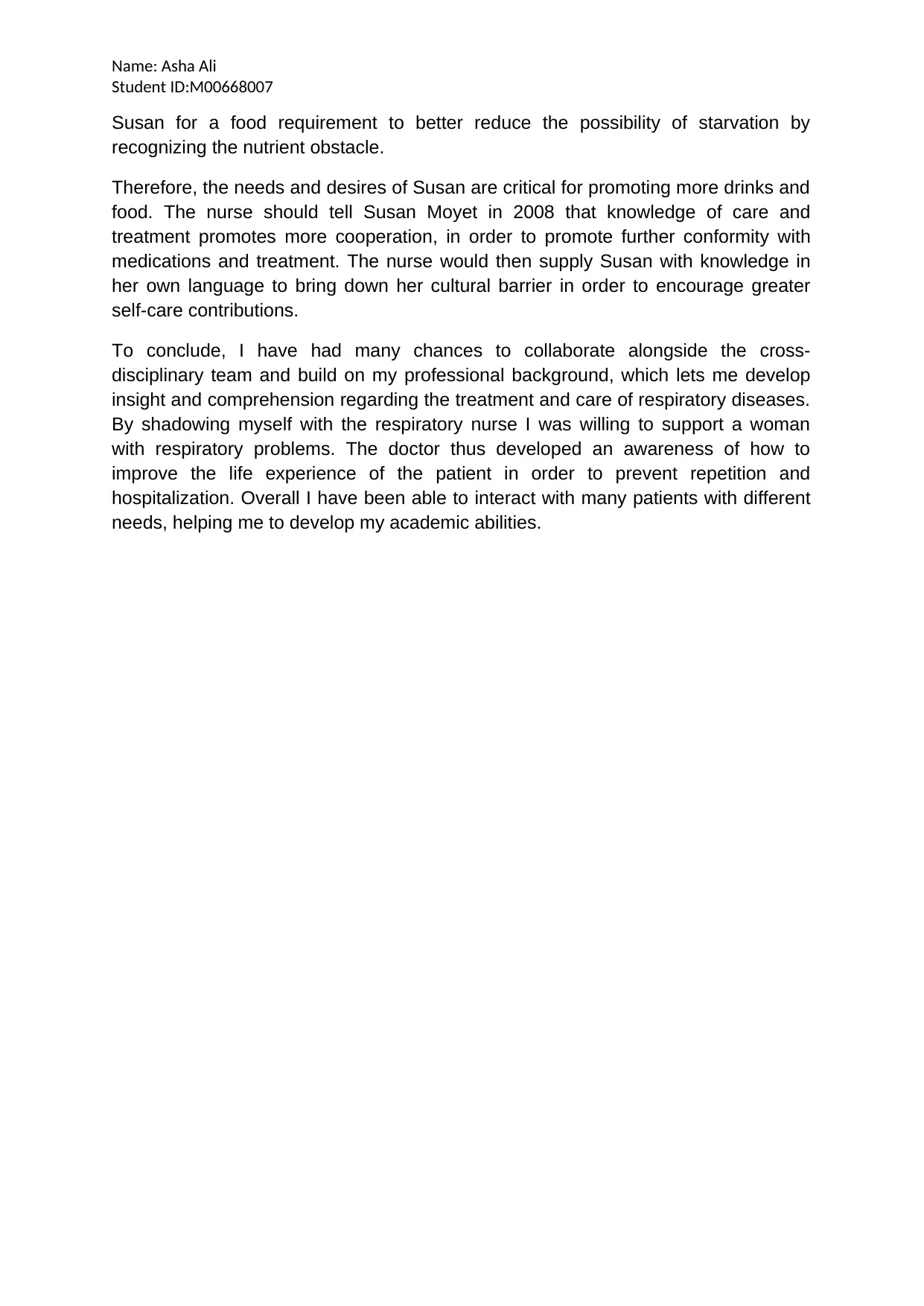
Name: Asha Ali
Student ID:M00668007
Susan for a food requirement to better reduce the possibility of starvation by
recognizing the nutrient obstacle.
Therefore, the needs and desires of Susan are critical for promoting more drinks and
food. The nurse should tell Susan Moyet in 2008 that knowledge of care and
treatment promotes more cooperation, in order to promote further conformity with
medications and treatment. The nurse would then supply Susan with knowledge in
her own language to bring down her cultural barrier in order to encourage greater
self-care contributions.
To conclude, I have had many chances to collaborate alongside the cross-
disciplinary team and build on my professional background, which lets me develop
insight and comprehension regarding the treatment and care of respiratory diseases.
By shadowing myself with the respiratory nurse I was willing to support a woman
with respiratory problems. The doctor thus developed an awareness of how to
improve the life experience of the patient in order to prevent repetition and
hospitalization. Overall I have been able to interact with many patients with different
needs, helping me to develop my academic abilities.
Student ID:M00668007
Susan for a food requirement to better reduce the possibility of starvation by
recognizing the nutrient obstacle.
Therefore, the needs and desires of Susan are critical for promoting more drinks and
food. The nurse should tell Susan Moyet in 2008 that knowledge of care and
treatment promotes more cooperation, in order to promote further conformity with
medications and treatment. The nurse would then supply Susan with knowledge in
her own language to bring down her cultural barrier in order to encourage greater
self-care contributions.
To conclude, I have had many chances to collaborate alongside the cross-
disciplinary team and build on my professional background, which lets me develop
insight and comprehension regarding the treatment and care of respiratory diseases.
By shadowing myself with the respiratory nurse I was willing to support a woman
with respiratory problems. The doctor thus developed an awareness of how to
improve the life experience of the patient in order to prevent repetition and
hospitalization. Overall I have been able to interact with many patients with different
needs, helping me to develop my academic abilities.
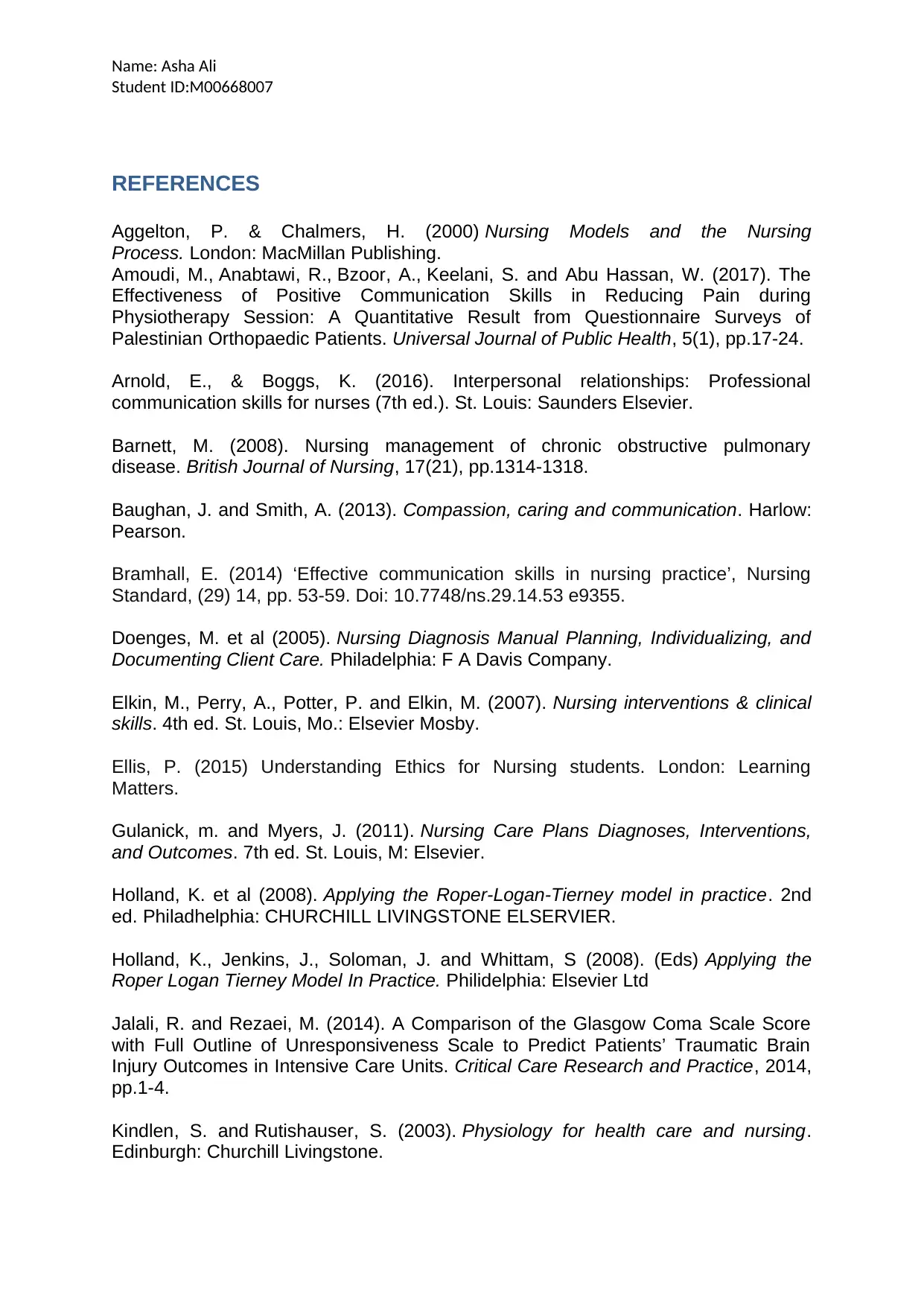
Name: Asha Ali
Student ID:M00668007
REFERENCES
Aggelton, P. & Chalmers, H. (2000) Nursing Models and the Nursing
Process. London: MacMillan Publishing.
Amoudi, M., Anabtawi, R., Bzoor, A., Keelani, S. and Abu Hassan, W. (2017). The
Effectiveness of Positive Communication Skills in Reducing Pain during
Physiotherapy Session: A Quantitative Result from Questionnaire Surveys of
Palestinian Orthopaedic Patients. Universal Journal of Public Health, 5(1), pp.17-24.
Arnold, E., & Boggs, K. (2016). Interpersonal relationships: Professional
communication skills for nurses (7th ed.). St. Louis: Saunders Elsevier.
Barnett, M. (2008). Nursing management of chronic obstructive pulmonary
disease. British Journal of Nursing, 17(21), pp.1314-1318.
Baughan, J. and Smith, A. (2013). Compassion, caring and communication. Harlow:
Pearson.
Bramhall, E. (2014) ‘Effective communication skills in nursing practice’, Nursing
Standard, (29) 14, pp. 53-59. Doi: 10.7748/ns.29.14.53 e9355.
Doenges, M. et al (2005). Nursing Diagnosis Manual Planning, Individualizing, and
Documenting Client Care. Philadelphia: F A Davis Company.
Elkin, M., Perry, A., Potter, P. and Elkin, M. (2007). Nursing interventions & clinical
skills. 4th ed. St. Louis, Mo.: Elsevier Mosby.
Ellis, P. (2015) Understanding Ethics for Nursing students. London: Learning
Matters.
Gulanick, m. and Myers, J. (2011). Nursing Care Plans Diagnoses, Interventions,
and Outcomes. 7th ed. St. Louis, M: Elsevier.
Holland, K. et al (2008). Applying the Roper-Logan-Tierney model in practice. 2nd
ed. Philadhelphia: CHURCHILL LIVINGSTONE ELSERVIER.
Holland, K., Jenkins, J., Soloman, J. and Whittam, S (2008). (Eds) Applying the
Roper Logan Tierney Model In Practice. Philidelphia: Elsevier Ltd
Jalali, R. and Rezaei, M. (2014). A Comparison of the Glasgow Coma Scale Score
with Full Outline of Unresponsiveness Scale to Predict Patients’ Traumatic Brain
Injury Outcomes in Intensive Care Units. Critical Care Research and Practice, 2014,
pp.1-4.
Kindlen, S. and Rutishauser, S. (2003). Physiology for health care and nursing.
Edinburgh: Churchill Livingstone.
Student ID:M00668007
REFERENCES
Aggelton, P. & Chalmers, H. (2000) Nursing Models and the Nursing
Process. London: MacMillan Publishing.
Amoudi, M., Anabtawi, R., Bzoor, A., Keelani, S. and Abu Hassan, W. (2017). The
Effectiveness of Positive Communication Skills in Reducing Pain during
Physiotherapy Session: A Quantitative Result from Questionnaire Surveys of
Palestinian Orthopaedic Patients. Universal Journal of Public Health, 5(1), pp.17-24.
Arnold, E., & Boggs, K. (2016). Interpersonal relationships: Professional
communication skills for nurses (7th ed.). St. Louis: Saunders Elsevier.
Barnett, M. (2008). Nursing management of chronic obstructive pulmonary
disease. British Journal of Nursing, 17(21), pp.1314-1318.
Baughan, J. and Smith, A. (2013). Compassion, caring and communication. Harlow:
Pearson.
Bramhall, E. (2014) ‘Effective communication skills in nursing practice’, Nursing
Standard, (29) 14, pp. 53-59. Doi: 10.7748/ns.29.14.53 e9355.
Doenges, M. et al (2005). Nursing Diagnosis Manual Planning, Individualizing, and
Documenting Client Care. Philadelphia: F A Davis Company.
Elkin, M., Perry, A., Potter, P. and Elkin, M. (2007). Nursing interventions & clinical
skills. 4th ed. St. Louis, Mo.: Elsevier Mosby.
Ellis, P. (2015) Understanding Ethics for Nursing students. London: Learning
Matters.
Gulanick, m. and Myers, J. (2011). Nursing Care Plans Diagnoses, Interventions,
and Outcomes. 7th ed. St. Louis, M: Elsevier.
Holland, K. et al (2008). Applying the Roper-Logan-Tierney model in practice. 2nd
ed. Philadhelphia: CHURCHILL LIVINGSTONE ELSERVIER.
Holland, K., Jenkins, J., Soloman, J. and Whittam, S (2008). (Eds) Applying the
Roper Logan Tierney Model In Practice. Philidelphia: Elsevier Ltd
Jalali, R. and Rezaei, M. (2014). A Comparison of the Glasgow Coma Scale Score
with Full Outline of Unresponsiveness Scale to Predict Patients’ Traumatic Brain
Injury Outcomes in Intensive Care Units. Critical Care Research and Practice, 2014,
pp.1-4.
Kindlen, S. and Rutishauser, S. (2003). Physiology for health care and nursing.
Edinburgh: Churchill Livingstone.
Paraphrase This Document
Need a fresh take? Get an instant paraphrase of this document with our AI Paraphraser
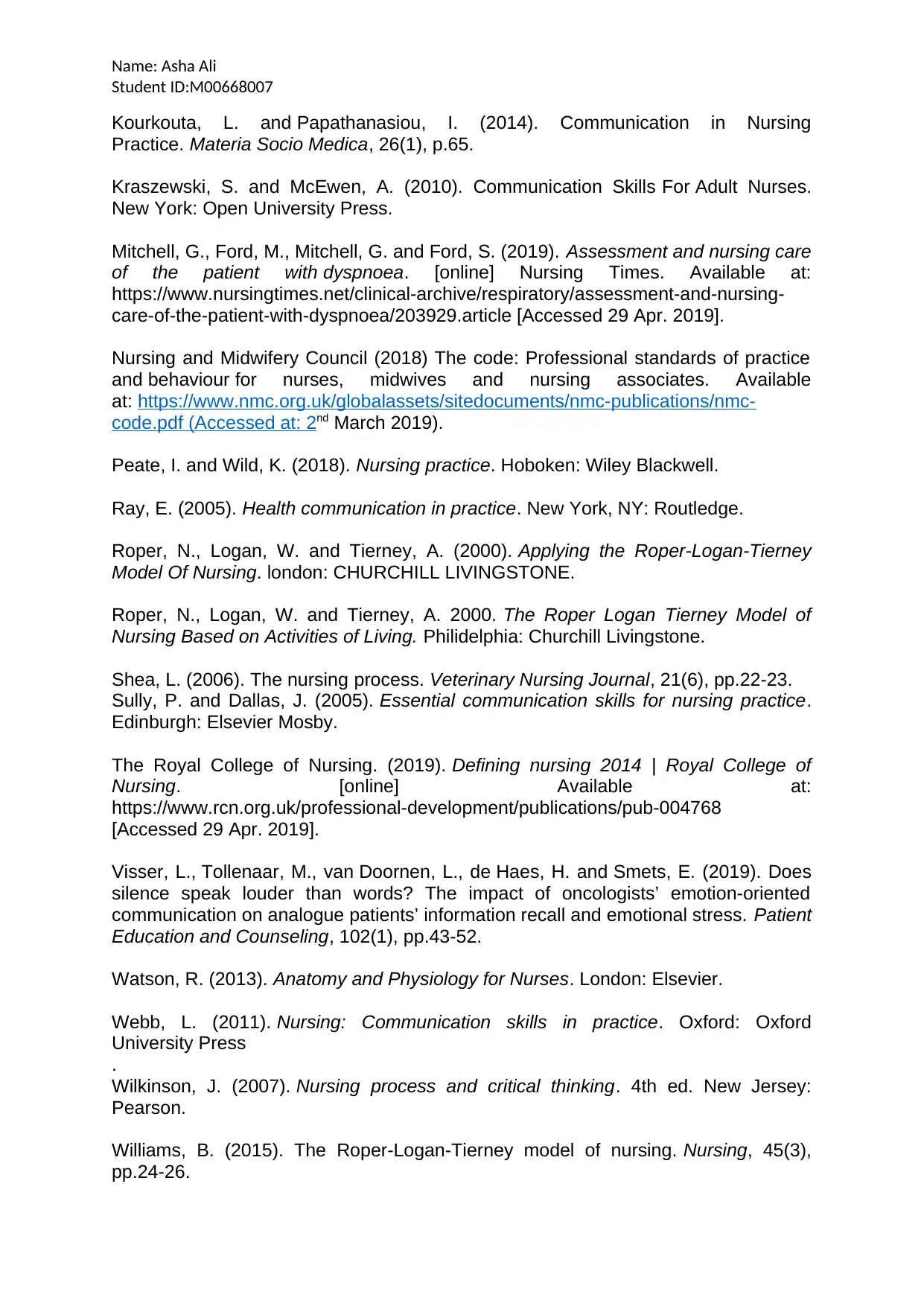
Name: Asha Ali
Student ID:M00668007
Kourkouta, L. and Papathanasiou, I. (2014). Communication in Nursing
Practice. Materia Socio Medica, 26(1), p.65.
Kraszewski, S. and McEwen, A. (2010). Communication Skills For Adult Nurses.
New York: Open University Press.
Mitchell, G., Ford, M., Mitchell, G. and Ford, S. (2019). Assessment and nursing care
of the patient with dyspnoea. [online] Nursing Times. Available at:
https://www.nursingtimes.net/clinical-archive/respiratory/assessment-and-nursing-
care-of-the-patient-with-dyspnoea/203929.article [Accessed 29 Apr. 2019].
Nursing and Midwifery Council (2018) The code: Professional standards of practice
and behaviour for nurses, midwives and nursing associates. Available
at: https://www.nmc.org.uk/globalassets/sitedocuments/nmc-publications/nmc-
code.pdf (Accessed at: 2nd March 2019).
Peate, I. and Wild, K. (2018). Nursing practice. Hoboken: Wiley Blackwell.
Ray, E. (2005). Health communication in practice. New York, NY: Routledge.
Roper, N., Logan, W. and Tierney, A. (2000). Applying the Roper-Logan-Tierney
Model Of Nursing. london: CHURCHILL LIVINGSTONE.
Roper, N., Logan, W. and Tierney, A. 2000. The Roper Logan Tierney Model of
Nursing Based on Activities of Living. Philidelphia: Churchill Livingstone.
Shea, L. (2006). The nursing process. Veterinary Nursing Journal, 21(6), pp.22-23.
Sully, P. and Dallas, J. (2005). Essential communication skills for nursing practice.
Edinburgh: Elsevier Mosby.
The Royal College of Nursing. (2019). Defining nursing 2014 | Royal College of
Nursing. [online] Available at:
https://www.rcn.org.uk/professional-development/publications/pub-004768
[Accessed 29 Apr. 2019].
Visser, L., Tollenaar, M., van Doornen, L., de Haes, H. and Smets, E. (2019). Does
silence speak louder than words? The impact of oncologists’ emotion-oriented
communication on analogue patients’ information recall and emotional stress. Patient
Education and Counseling, 102(1), pp.43-52.
Watson, R. (2013). Anatomy and Physiology for Nurses. London: Elsevier.
Webb, L. (2011). Nursing: Communication skills in practice. Oxford: Oxford
University Press
.
Wilkinson, J. (2007). Nursing process and critical thinking. 4th ed. New Jersey:
Pearson.
Williams, B. (2015). The Roper-Logan-Tierney model of nursing. Nursing, 45(3),
pp.24-26.
Student ID:M00668007
Kourkouta, L. and Papathanasiou, I. (2014). Communication in Nursing
Practice. Materia Socio Medica, 26(1), p.65.
Kraszewski, S. and McEwen, A. (2010). Communication Skills For Adult Nurses.
New York: Open University Press.
Mitchell, G., Ford, M., Mitchell, G. and Ford, S. (2019). Assessment and nursing care
of the patient with dyspnoea. [online] Nursing Times. Available at:
https://www.nursingtimes.net/clinical-archive/respiratory/assessment-and-nursing-
care-of-the-patient-with-dyspnoea/203929.article [Accessed 29 Apr. 2019].
Nursing and Midwifery Council (2018) The code: Professional standards of practice
and behaviour for nurses, midwives and nursing associates. Available
at: https://www.nmc.org.uk/globalassets/sitedocuments/nmc-publications/nmc-
code.pdf (Accessed at: 2nd March 2019).
Peate, I. and Wild, K. (2018). Nursing practice. Hoboken: Wiley Blackwell.
Ray, E. (2005). Health communication in practice. New York, NY: Routledge.
Roper, N., Logan, W. and Tierney, A. (2000). Applying the Roper-Logan-Tierney
Model Of Nursing. london: CHURCHILL LIVINGSTONE.
Roper, N., Logan, W. and Tierney, A. 2000. The Roper Logan Tierney Model of
Nursing Based on Activities of Living. Philidelphia: Churchill Livingstone.
Shea, L. (2006). The nursing process. Veterinary Nursing Journal, 21(6), pp.22-23.
Sully, P. and Dallas, J. (2005). Essential communication skills for nursing practice.
Edinburgh: Elsevier Mosby.
The Royal College of Nursing. (2019). Defining nursing 2014 | Royal College of
Nursing. [online] Available at:
https://www.rcn.org.uk/professional-development/publications/pub-004768
[Accessed 29 Apr. 2019].
Visser, L., Tollenaar, M., van Doornen, L., de Haes, H. and Smets, E. (2019). Does
silence speak louder than words? The impact of oncologists’ emotion-oriented
communication on analogue patients’ information recall and emotional stress. Patient
Education and Counseling, 102(1), pp.43-52.
Watson, R. (2013). Anatomy and Physiology for Nurses. London: Elsevier.
Webb, L. (2011). Nursing: Communication skills in practice. Oxford: Oxford
University Press
.
Wilkinson, J. (2007). Nursing process and critical thinking. 4th ed. New Jersey:
Pearson.
Williams, B. (2015). The Roper-Logan-Tierney model of nursing. Nursing, 45(3),
pp.24-26.
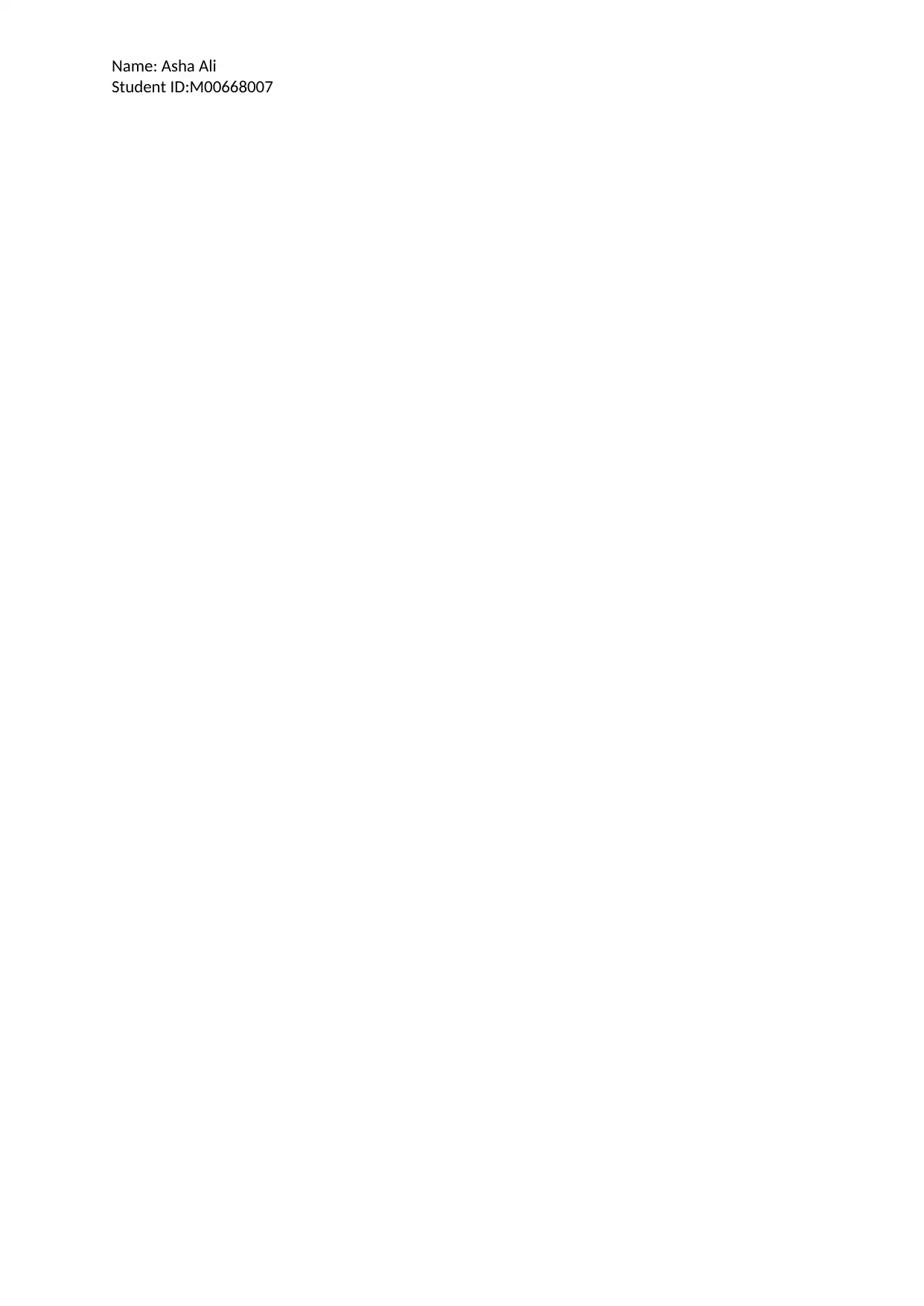
Name: Asha Ali
Student ID:M00668007
Student ID:M00668007
1 out of 9
Related Documents
Your All-in-One AI-Powered Toolkit for Academic Success.
+13062052269
info@desklib.com
Available 24*7 on WhatsApp / Email
![[object Object]](/_next/static/media/star-bottom.7253800d.svg)
Unlock your academic potential
© 2024 | Zucol Services PVT LTD | All rights reserved.




